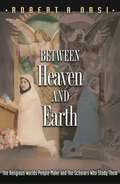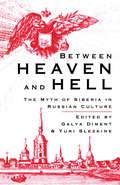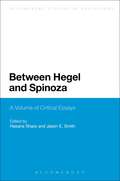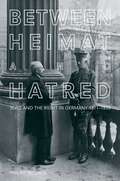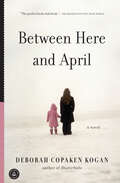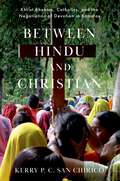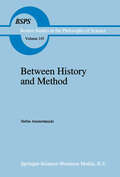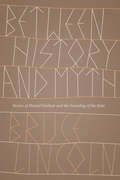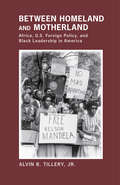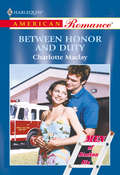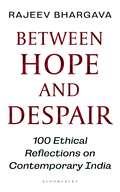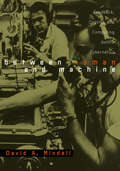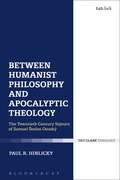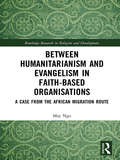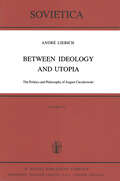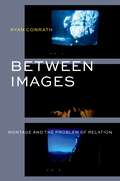- Table View
- List View
Between Heaven and Earth: The Religious Worlds People Make and the Scholars Who Study Them (PDF)
by Robert A. OrsiBetween Heaven and Earth explores the relationships men, women, and children have formed with the Virgin Mary and the saints in twentieth-century American Catholic history, and reflects, more broadly, on how people live in the company of sacred figures and how these relationships shape the ties between people on earth. In this boldly argued and beautifully written book, Robert Orsi also considers how scholars of religion occupy the ground in between belief and analysis, faith and scholarship. Orsi infuses his analysis with an autobiographical voice steeped in his own Italian-American Catholic background--from the devotion of his uncle Sal, who had cerebral palsy, to a "crippled saint," Margaret of Castello; to the bond of his Tuscan grandmother with Saint Gemma Galgani. Religion exists not as a medium of making meanings, Orsi maintains, but as a network of relationships between heaven and earth involving people of all ages as well as the many sacred figures they hold dear. Orsi argues that modern academic theorizing about religion has long sanctioned dubious distinctions between "good" or "real" religious expression on the one hand and "bad" or "bogus" religion on the other, which marginalize these everyday relationships with sacred figures. This book is a brilliant critical inquiry into the lives that people make, for better or worse, between heaven and earth, and into the ways scholars of religion could better study of these worlds.
Between Heaven and Hell: The Myth of Siberia in Russian Culture
by G. Diment Y. SlezkineSiberia has no history of independent political existence, no claim to a separate ethnic identity, and no clear borders. Yet, it could be said that the elusive country 'behind the Urals' is the most real and the most durable part of the Russian landscape. For centuries, Siberia has been represented as Russia's alter ego,as the heavenly or infernal antithesis to the perceived complexity or shallowness of Russian life. It has been both the frightening heart of darkness and a fabulous land of plenty; the 'House of the Dead' and the realm of utter freedom; a frozen wasteland and a colourful frontier; a dumping ground for Russia's rejects and the last refuge of its lost innocence. The contributors to Between Heaven and Hell examine the origin, nature, and implications of these images from historical, literary, geographical, anthropological, and linguistic perspectives. They create a striking, fascinating picture of this enormous and mysterious land.
Between Hegel and Spinoza: A Volume of Critical Essays (Bloomsbury Studies in Philosophy)
by Hasana Sharp Jason E. SmithRecentwork in political philosophy and the history of ideas presents Spinoza andHegel as the most powerful living alternatives to mainstream Enlightenmentthought. Yet, for many philosophers and political theorists today, one mustchoose between Hegel or Spinoza. As Deleuze's influential interpretationmaintains, Hegel exemplifies and promotes the modern "cults of death," whileSpinoza embodies an irrepressible "appetite for living." Hegel is the figure ofnegation, while Spinoza is the thinker of "pure affirmation". Yet, betweenHegel and Spinoza there is not only opposition. This collection of essays seeksto find the suppressed kinship between Hegel and Spinoza. Both philosophersoffer vigorous and profound alternatives to the methodological individualism ofclassical liberalism. Likewise, they sketch portraits of reason that arecontext-responsive and emotionally contoured, offering an especially rich appreciationof our embodied and historical existence. The authors of this collectioncarefully lay the groundwork for a complex and delicate alliance between thesetwo great iconoclasts, both within and against the Enlightenment tradition.
Between Hegel and Spinoza: A Volume of Critical Essays (Bloomsbury Studies in Philosophy)
by Hasana Sharp Jason E. SmithRecentwork in political philosophy and the history of ideas presents Spinoza andHegel as the most powerful living alternatives to mainstream Enlightenmentthought. Yet, for many philosophers and political theorists today, one mustchoose between Hegel or Spinoza. As Deleuze's influential interpretationmaintains, Hegel exemplifies and promotes the modern "cults of death," whileSpinoza embodies an irrepressible "appetite for living." Hegel is the figure ofnegation, while Spinoza is the thinker of "pure affirmation". Yet, betweenHegel and Spinoza there is not only opposition. This collection of essays seeksto find the suppressed kinship between Hegel and Spinoza. Both philosophersoffer vigorous and profound alternatives to the methodological individualism ofclassical liberalism. Likewise, they sketch portraits of reason that arecontext-responsive and emotionally contoured, offering an especially rich appreciationof our embodied and historical existence. The authors of this collectioncarefully lay the groundwork for a complex and delicate alliance between thesetwo great iconoclasts, both within and against the Enlightenment tradition.
Between Heimat and Hatred: Jews and the Right in Germany, 1871-1935
by Philipp NielsenIn the decades between German unification and the demise of the Weimar Republic, German Jewry negotiated their collective and individual identity under the impression of legal emancipation, continued antisemitism, the emergence of Zionism and Socialism, the First World War, and revolution and the republic. For many German Jews liberalism and also increasingly Socialism became attractive propositions. Yet conservative parties and political positions right-of-center also held appeal for some German Jews. Between Heimat and Hatred studies German Jews involved in ventures that were from the beginning, or became increasingly, of the Right. Jewish agricultural settlement, Jews' participation in the so-called "Defense of Germandom in the East", their place in military and veteran circles and finally right-of-center politics form the core of this book. These topics created a web of social activities and political persuasions neither entirely conservative nor entirely liberal. For those German Jews engaging with these issues, their motivation came from sincere love of their German Heimat-a term for home imbued with a deep sense of belonging-and from their middle-class environment, as well as to repudiate antisemitic stereotypes of rootlessness, intellectualism or cosmopolitanism. This tension stands at the heart of the book. The book also asks when did the need for self-defense start to outweigh motivations of patriotism and class? Until when could German Jews espouse views to the right of the political spectrum without appearing extreme to either Jews or non-Jews? In an exploration of identity and exclusion, Philipp Nielsen locates the moments when active Jewish members of conservative projects became the radical other. He notes that the decisive stage of the transformation of the German Right occurred precisely during a period of republican stabilization, when even mainstream right-of-center politics abandoned the state-centric, Volk-based ethnic concepts of the Weimar republic. The book builds on recent studies of Jews' relation to German nationalism, the experience of German Jews away from the large cities, and the increasing interest in Germans' obsession with regional roots and the East. The study follows these lines of inquiry to investigate the participation of some German Jews in projects dedicated to originally, or increasingly, illiberal projects. As such it shines light on an area in which Jewish participation has thus far only been treated as an afterthought and illuminates both Jewish and German history afresh.
Between Heimat and Hatred: Jews and the Right in Germany, 1871-1935
by Philipp NielsenIn the decades between German unification and the demise of the Weimar Republic, German Jewry negotiated their collective and individual identity under the impression of legal emancipation, continued antisemitism, the emergence of Zionism and Socialism, the First World War, and revolution and the republic. For many German Jews liberalism and also increasingly Socialism became attractive propositions. Yet conservative parties and political positions right-of-center also held appeal for some German Jews. Between Heimat and Hatred studies German Jews involved in ventures that were from the beginning, or became increasingly, of the Right. Jewish agricultural settlement, Jews' participation in the so-called "Defense of Germandom in the East", their place in military and veteran circles and finally right-of-center politics form the core of this book. These topics created a web of social activities and political persuasions neither entirely conservative nor entirely liberal. For those German Jews engaging with these issues, their motivation came from sincere love of their German Heimat-a term for home imbued with a deep sense of belonging-and from their middle-class environment, as well as to repudiate antisemitic stereotypes of rootlessness, intellectualism or cosmopolitanism. This tension stands at the heart of the book. The book also asks when did the need for self-defense start to outweigh motivations of patriotism and class? Until when could German Jews espouse views to the right of the political spectrum without appearing extreme to either Jews or non-Jews? In an exploration of identity and exclusion, Philipp Nielsen locates the moments when active Jewish members of conservative projects became the radical other. He notes that the decisive stage of the transformation of the German Right occurred precisely during a period of republican stabilization, when even mainstream right-of-center politics abandoned the state-centric, Volk-based ethnic concepts of the Weimar republic. The book builds on recent studies of Jews' relation to German nationalism, the experience of German Jews away from the large cities, and the increasing interest in Germans' obsession with regional roots and the East. The study follows these lines of inquiry to investigate the participation of some German Jews in projects dedicated to originally, or increasingly, illiberal projects. As such it shines light on an area in which Jewish participation has thus far only been treated as an afterthought and illuminates both Jewish and German history afresh.
Between Here and April
by Deborah Copaken Kogan&“A haunting work of ambition and dimension.&”—Meg Wolitzer, author of The Female Persuasion When a deep-seated memory suddenly surfaces, Elizabeth Burns becomes obsessed with the long-ago disappearance of her childhood friend April Cassidy. Driven to investigate, Elizabeth discovers a thirty-five-year-old newspaper article revealing the details that had been hidden from her as a child—shocking revelations about April's mother, Adele. Elizabeth, now herself a mother, seeks out anyone who might help piece together the final months, days, and hours of this troubled woman's life, but the answers yield only more questions. And those questions lead back to Elizabeth's own life: her own compromised marriage, her increasing self-doubt and dissatisfaction, and finally, a fearsome reckoning with what it means to be a wife and mother.
Between Hindu and Christian: Khrist Bhaktas, Catholics, and the Negotiation of Devotion in Banaras
by Kerry P. San ChiricoOn the second Saturday of each month, on the outskirts of the ancient city of Varanasi, Shiva's own city, thousands of shudra and Dalit devotees worship Yesu (Jesus) at a Catholic ashram. In an open-air pavilion more than three thousand women and men alternately sit, stand, and sing; they offer testimonials of healing, and receive the blessings of encounter from an unlikely deity. Facing this ocean of humanity is a 12-foot billboard Christ, arms outstretched, urging in Hindi: "Come to me all you who are weary and heavy laden and I will give you rest." At the lectern stands a saffron-clad priest offering teachings punctuated by hallelujahs, met with boisterous echoes. Between Hindu and Christian sheds light on a novel movement of low and no-caste devotees worshipping Jesus in the purported heart of Hindu civilization. Through thick description and analysis, and by attending to devotees and clergy in their own voices, Kerry P. C. San Chirico examines the worldview and ways of life of these Khrist Bhaktas, or devotees of Jesus, along with the Catholic priests and nuns who mediate Jesus, Mary, and other members of the Catholic pantheon in a place hardly associated with Jesus or Christianity. San Chirico places this movement within the context of the devotional history of the Banaras region, the history of Indian Christianity, the rise of low caste and Dalit emancipatory strategies, and the ascendance of Hindu nationalism. Attending to convergences and disparities between devotional Hinduism and charismatic Catholicism, Between Hindu and Christian demonstrates that religious categories are not nearly as distinct as they often seem.
Between Hindu and Christian: Khrist Bhaktas, Catholics, and the Negotiation of Devotion in Banaras
by Kerry P. San ChiricoOn the second Saturday of each month, on the outskirts of the ancient city of Varanasi, Shiva's own city, thousands of shudra and Dalit devotees worship Yesu (Jesus) at a Catholic ashram. In an open-air pavilion more than three thousand women and men alternately sit, stand, and sing; they offer testimonials of healing, and receive the blessings of encounter from an unlikely deity. Facing this ocean of humanity is a 12-foot billboard Christ, arms outstretched, urging in Hindi: "Come to me all you who are weary and heavy laden and I will give you rest." At the lectern stands a saffron-clad priest offering teachings punctuated by hallelujahs, met with boisterous echoes. Between Hindu and Christian sheds light on a novel movement of low and no-caste devotees worshipping Jesus in the purported heart of Hindu civilization. Through thick description and analysis, and by attending to devotees and clergy in their own voices, Kerry P. C. San Chirico examines the worldview and ways of life of these Khrist Bhaktas, or devotees of Jesus, along with the Catholic priests and nuns who mediate Jesus, Mary, and other members of the Catholic pantheon in a place hardly associated with Jesus or Christianity. San Chirico places this movement within the context of the devotional history of the Banaras region, the history of Indian Christianity, the rise of low caste and Dalit emancipatory strategies, and the ascendance of Hindu nationalism. Attending to convergences and disparities between devotional Hinduism and charismatic Catholicism, Between Hindu and Christian demonstrates that religious categories are not nearly as distinct as they often seem.
Between History and Method: Disputes about the Rationality of Science (Boston Studies in the Philosophy and History of Science #145)
by S. AmsterdamskiIn this book I have tried to develop further the ideas expressed in my previous work, Between Experience and Metaphysics, which was published in the same series in 1975. Several years have passed since the original Polish edition (and then 1 the Italian translation) of this book appeared. The fact that the principal ideas expressed in it have withstood, as I see it, the brunt of criticism, has led me to remain basically with the original text. Two main changes have, however, been introduced. First, I have added an Appendix containing the original version of a paper I presented at the Wissenschaftskolleg zu Berlin in June 1988 and a short postscript to that paper referring to comments made during two dis cussions at the Kolleg. Let me briefly explain the reason for this addition. In recent years the landscape for historical and philosophical in terpretation of the evolution of scientific knowledge has altered. The strongest of the new contenders for epistemological recognition are social constructivists, who analyze in detail how knowledge is produced within specific social settings, including the instruments and procedures of par ticular laboratories and the economic and political realities of particular scientific communities. The local character of these studies raises the question of whether they can ever provide generalizable epistemological claims.
Between History and Myth: Stories of Harald Fairhair and the Founding of the State
by Bruce LincolnAll groups tell stories about their beginnings. Such tales are oft-repeated, finely wrought, and usually much beloved. Among those institutions most in need of an impressive creation account is the state: it’s one of the primary ways states attempt to legitimate themselves. But such founding narratives invite revisionist retellings that modify details of the story in ways that undercut, ironize, and even ridicule the state’s ideal self-representation. Medieval accounts of how Norway was unified by its first king provide a lively, revealing, and wonderfully entertaining example of this process. Taking the story of how Harald Fairhair unified Norway in the ninth century as its central example, Bruce Lincoln illuminates the way a state’s foundation story blurs the distinction between history and myth and how variant tellings of origin stories provide opportunities for dissidence and subversion as subtle—or not so subtle—modifications are introduced through details of character, incident, and plot structure. Lincoln reveals a pattern whereby texts written in Iceland were more critical and infinitely more subtle than those produced in Norway, reflecting the fact that the former had a dual audience: not just the Norwegian court, but also Icelanders of the twelfth and thirteenth centuries, whose ancestors had fled from Harald and founded the only non-monarchic, indeed anti-monarchic, state in medieval Europe. Between History and Myth will appeal not only to specialists in Scandinavian literature and history but also to anyone interested in memory and narrative.
Between History and Myth: Stories of Harald Fairhair and the Founding of the State
by Bruce LincolnAll groups tell stories about their beginnings. Such tales are oft-repeated, finely wrought, and usually much beloved. Among those institutions most in need of an impressive creation account is the state: it’s one of the primary ways states attempt to legitimate themselves. But such founding narratives invite revisionist retellings that modify details of the story in ways that undercut, ironize, and even ridicule the state’s ideal self-representation. Medieval accounts of how Norway was unified by its first king provide a lively, revealing, and wonderfully entertaining example of this process. Taking the story of how Harald Fairhair unified Norway in the ninth century as its central example, Bruce Lincoln illuminates the way a state’s foundation story blurs the distinction between history and myth and how variant tellings of origin stories provide opportunities for dissidence and subversion as subtle—or not so subtle—modifications are introduced through details of character, incident, and plot structure. Lincoln reveals a pattern whereby texts written in Iceland were more critical and infinitely more subtle than those produced in Norway, reflecting the fact that the former had a dual audience: not just the Norwegian court, but also Icelanders of the twelfth and thirteenth centuries, whose ancestors had fled from Harald and founded the only non-monarchic, indeed anti-monarchic, state in medieval Europe. Between History and Myth will appeal not only to specialists in Scandinavian literature and history but also to anyone interested in memory and narrative.
Between History and Myth: Stories of Harald Fairhair and the Founding of the State
by Bruce LincolnAll groups tell stories about their beginnings. Such tales are oft-repeated, finely wrought, and usually much beloved. Among those institutions most in need of an impressive creation account is the state: it’s one of the primary ways states attempt to legitimate themselves. But such founding narratives invite revisionist retellings that modify details of the story in ways that undercut, ironize, and even ridicule the state’s ideal self-representation. Medieval accounts of how Norway was unified by its first king provide a lively, revealing, and wonderfully entertaining example of this process. Taking the story of how Harald Fairhair unified Norway in the ninth century as its central example, Bruce Lincoln illuminates the way a state’s foundation story blurs the distinction between history and myth and how variant tellings of origin stories provide opportunities for dissidence and subversion as subtle—or not so subtle—modifications are introduced through details of character, incident, and plot structure. Lincoln reveals a pattern whereby texts written in Iceland were more critical and infinitely more subtle than those produced in Norway, reflecting the fact that the former had a dual audience: not just the Norwegian court, but also Icelanders of the twelfth and thirteenth centuries, whose ancestors had fled from Harald and founded the only non-monarchic, indeed anti-monarchic, state in medieval Europe. Between History and Myth will appeal not only to specialists in Scandinavian literature and history but also to anyone interested in memory and narrative.
Between History and Myth: Stories of Harald Fairhair and the Founding of the State
by Bruce LincolnAll groups tell stories about their beginnings. Such tales are oft-repeated, finely wrought, and usually much beloved. Among those institutions most in need of an impressive creation account is the state: it’s one of the primary ways states attempt to legitimate themselves. But such founding narratives invite revisionist retellings that modify details of the story in ways that undercut, ironize, and even ridicule the state’s ideal self-representation. Medieval accounts of how Norway was unified by its first king provide a lively, revealing, and wonderfully entertaining example of this process. Taking the story of how Harald Fairhair unified Norway in the ninth century as its central example, Bruce Lincoln illuminates the way a state’s foundation story blurs the distinction between history and myth and how variant tellings of origin stories provide opportunities for dissidence and subversion as subtle—or not so subtle—modifications are introduced through details of character, incident, and plot structure. Lincoln reveals a pattern whereby texts written in Iceland were more critical and infinitely more subtle than those produced in Norway, reflecting the fact that the former had a dual audience: not just the Norwegian court, but also Icelanders of the twelfth and thirteenth centuries, whose ancestors had fled from Harald and founded the only non-monarchic, indeed anti-monarchic, state in medieval Europe. Between History and Myth will appeal not only to specialists in Scandinavian literature and history but also to anyone interested in memory and narrative.
Between Homeland and Motherland: Africa, U.S. Foreign Policy, and Black Leadership in America (Cornell Paperbacks Ser.)
by Alvin B. Tillery Jr.In Between Homeland and Motherland, Alvin B. Tillery Jr. considers the history of political engagement with Africa on the part of African Americans, beginning with the birth of Paul Cuffe’s back-to-Africa movement in the Federal Period to the Congressional Black Caucus’ struggle to reach consensus on the African Growth and Opportunity Act of 2000. In contrast to the prevailing view that pan-Africanism has been the dominant ideology guiding black leaders in formulating foreign policy positions toward Africa, Tillery highlights the importance of domestic politics and factors within the African American community.Employing an innovative multimethod approach that combines archival research, statistical modeling, and interviews, Tillery argues that among African American elites—activists, intellectuals, and politicians—factors internal to the community played a large role in shaping their approach to African issues, and that shaping U.S. policy toward Africa was often secondary to winning political battles in the domestic arena. At the same time, Africa and its interests were important to America’s black elite, and Tillery’s analysis reveals that many black leaders have strong attachments to the "motherland." Spanning two centuries of African American engagement with Africa, this book shows how black leaders continuously balanced national, transnational, and community impulses, whether distancing themselves from Marcus Garvey’s back-to-Africa movement, supporting the anticolonialism movements of the 1950s, or opposing South African apartheid in the 1980s.
Between Honor And Duty (Mills And Boon American Romance Ser.)
by Charlotte MaclayFIREMAN REPORT Name: Logan StrongStatus: Torn between loyalty to a fallen firefighter and smoldering passion for the man's widow
Between Hope and Despair: 100 Ethical Reflections on Contemporary India
by Rajeev BhargavaIndia's collective ethical identity is under duress. We don't seem to currently agree on what our collective good is. Some groups believe that India is finally rediscovering its Hindu identity and becoming a great nation-state. For others, this change has brought us on the verge of losing our civilisational character of being inclusive but not any less Hindu. Is it possible to bring these groups with divergent views to discuss each other's point of view? And do so reasonably, with an open mind? Rajeev Bhargava thinks it is. He believes that the legitimate concerns of all those disenchanted with the idea of an inclusive, pluralist India can actually be addressed within the basic framework of India's constitutional democracy. Through these short, elegant and lucid reflections on contemporary events, he takes the readers to the founding narrative of the republic and clarifies its ethical ideals. Readers are asked to join the process of reflection, to criticise with empathy, particularly where the moral compass to properly guide individual and collective action is lost and offer positive appraisals where due. If we get the fundamentals of our original ethical vision right, then, Bhargava subtly suggests, we might yet save our country from further polarisation and may even heal some of its divisions.
Between Human and Machine: Feedback, Control, and Computing before Cybernetics (Johns Hopkins Studies in the History of Technology)
by David A. MindellToday, we associate the relationship between feedback, control, and computing with Norbert Wiener's 1948 formulation of cybernetics. But the theoretical and practical foundations for cybernetics, control engineering, and digital computing were laid earlier, between the two world wars. In Between Human and Machine: Feedback, Control, and Computing before Cybernetics, David A. Mindell shows how the modern sciences of systems emerged from disparate engineering cultures and their convergence during World War II. Mindell examines four different arenas of control systems research in the United States between the world wars: naval fire control, the Sperry Gyroscope Company, the Bell Telephone Laboratories, and Vannevar Bush's laboratory at MIT. Each of these institutional sites had unique technical problems, organizational imperatives, and working environments, and each fostered a distinct engineering culture. Each also developed technologies to represent the world in a machine.At the beginning of World War II, President Roosevelt established the National Defense Research Committee, one division of which was devoted to control systems. Mindell shows how the NDRC brought together representatives from the four pre-war engineering cultures, and how its projects synthesized conceptions of control, communications, and computing. By the time Wiener articulated his vision, these ideas were already suffusing through engineering. They would profoundly influence the digital world. As a new way to conceptualize the history of computing, this book will be of great interest to historians of science, technology, and culture, as well as computer scientists and theorists. Between Human and Machine: Feedback, Control, and Computing before Cybernetics
Between Humanist Philosophy and Apocalyptic Theology: The Twentieth Century Sojourn of Samuel Stefan Osusky
by Dr Paul R. HinlickySamuel Stefan Osusky was a leading intellectual in Slovak Lutheranism and a bishop in his church. In 1937 he delivered a prescient lecture to the assembled clergy, "The Philosophy of Fascism, Bolshevism and Hitlerism", that clearly foretold the dark days ahead. As wartime bishop, he co-authored a "Pastoral Letter on the Jewish Question", which publicly decried the deportation of Jews to Poland in 1942; in 1944 he was imprisoned by the Gestapo for giving moral support to the Slovak National Uprising against the fascist puppet regime.Paul R. Hinlicky traces the intellectual journey with ethical idealism's faith in the progressive theology of history that ended in dismay and disillusionment at the revolutionary pretensions of Marxism-Leninism. Hinlicky shows Osusky's dramatic rediscovery of the apocalyptic "the mother of Christian theology", and his input into the discussion of the dialectic of faith and reason after rationalism and fundamentalism.
Between Humanist Philosophy and Apocalyptic Theology: The Twentieth Century Sojourn of Samuel Stefan Osusky
by Paul R. HinlickySamuel Stefan Osusky was a leading intellectual in Slovak Lutheranism and a bishop in his church. In 1937 he delivered a prescient lecture to the assembled clergy, "The Philosophy of Fascism, Bolshevism and Hitlerism", that clearly foretold the dark days ahead. As wartime bishop, he co-authored a "Pastoral Letter on the Jewish Question", which publicly decried the deportation of Jews to Poland in 1942; in 1944 he was imprisoned by the Gestapo for giving moral support to the Slovak National Uprising against the fascist puppet regime.Paul R. Hinlicky traces the intellectual journey with ethical idealism's faith in the progressive theology of history that ended in dismay and disillusionment at the revolutionary pretensions of Marxism-Leninism. Hinlicky shows Osusky's dramatic rediscovery of the apocalyptic "the mother of Christian theology", and his input into the discussion of the dialectic of faith and reason after rationalism and fundamentalism.
Between Humanitarianism and Evangelism in Faith-based Organisations: A Case from the African Migration Route (Routledge Research in Religion and Development)
by May NgoReligion has always played an important, if often contested, role in the public domain. This book focuses on how faith-based organisations (FBOs) interact with the public sphere, showing how faith-based actors are themselves shaped by wider processes and global forces such as globalisation, migration, foreign policy and neoliberal markets. Focusing on a case study of an FBO in Morocco which gives aid to sub-Saharan African irregular migrants, the book reveals some of the challenges the organisation faces as it tries to negotiate at once local, national and international contexts through their particular Christian values. This book contends that the contradictions, tensions and ambiguities that arise are primarily a result of the organisation having to negotiate a normative global secular liberalism which requires a strict demarcation between religion and politics, and religion and the secular. Faith-based actors, particularly within humanitarianism, have to constantly navigate this divide and in examining the question of how religious values translate into humanitarian and development practices, categories such as religion, the secular and politics and the boundaries between them will need to be interrogated. This book explores the diversity and complexity of the work of FBOs and will be of great interest to students and researchers working at the intersections of humanitarianism and development studies, politics and religion.
Between Humanitarianism and Evangelism in Faith-based Organisations: A Case from the African Migration Route (Routledge Research in Religion and Development)
by May NgoReligion has always played an important, if often contested, role in the public domain. This book focuses on how faith-based organisations (FBOs) interact with the public sphere, showing how faith-based actors are themselves shaped by wider processes and global forces such as globalisation, migration, foreign policy and neoliberal markets. Focusing on a case study of an FBO in Morocco which gives aid to sub-Saharan African irregular migrants, the book reveals some of the challenges the organisation faces as it tries to negotiate at once local, national and international contexts through their particular Christian values. This book contends that the contradictions, tensions and ambiguities that arise are primarily a result of the organisation having to negotiate a normative global secular liberalism which requires a strict demarcation between religion and politics, and religion and the secular. Faith-based actors, particularly within humanitarianism, have to constantly navigate this divide and in examining the question of how religious values translate into humanitarian and development practices, categories such as religion, the secular and politics and the boundaries between them will need to be interrogated. This book explores the diversity and complexity of the work of FBOs and will be of great interest to students and researchers working at the intersections of humanitarianism and development studies, politics and religion.
Between Ideology and Utopia: The Politics and Philosophy of August Cieszkowski (Sovietica #39)
by A. LiebichNineteenth-century European intellectual history has given rise to such varied and abundant research that one is surprised to find certain important problems long identified and yet still relatively unexplored. Such is the case for certain aspects of the crucial transition from Hegel to Marx, for minority tendencies among French socialists and for the Messianic phenomenon, national and religious, so central to the period, particularly in Eastern Europe, and so rarely studied in detail. Certainly, these lacunae are exemplified by the absence of any com prehensive work on August Cieszkowski whose overall contribution to the history of the period may be marginal but whose specific role in each of the areas mentioned is both significant in itself and illustrative of certain wider problems. Cieszkowski first achieved recognition as the author of the Pro legomena zur Historiosophie in 1838. This short tract never became popular among the Berlin Hegelians for whom it was intended but it affected a number of radical intellectuals outside their circle. His next work, Gott und Palingenesie, was a defense of personal immortality against Hegelian revisionism. The following year, however, he founded as a bulwark of the Hegelian school the Philosophische Gesellschaft against external critics and internal dissolution.
Between Images: Montage and the Problem of Relation
by Ryan ConrathIn the early days of moving pictures, filmmakers learned that the montage could be an effective tool to show changes in time or locale. Casablanca's iconic travel montage is mimicked by filmmakers to this day. Since its use in Rocky, the training montage has become a staple for sports films. In the 2004 film Team America, the song "Montage" is a meta explanation of the device's universal use and understanding. Its history and affects are studied and practiced by student and professional filmmakers alike. "Between Images proposes a unique theory of montage a technique of relation: a way of rethinking and reshaping how humans relateDLto ourselves and each other, to the material world, to the planet and its nonhuman inhabitants. Historically, film criticism has cast editing in one of several roles: as a device of spatiotemporal continuity to maintain the viewer's investment in the story-world; as an agent of disorder that confounds conventions of realism to prompt the viewer's intellectual engagement; and as an expressionistic device for augmenting the duration and combination of shots to leave a sensory impression. While not abandoning such accounts, this book ventures closer to the heart of montage by distinguishing the space between images as itself a powerful source of political, emotional, and aesthetic formation. Venturing into an "expanded field of montage," this study traces the cut and the splice across photographic and cinematic media, where the space between images becomes a setting for navigating and renegotiating the terms of relation, of the "being-with" that connects all forms of life. Between Images brings together a diverse cast of established and emerging film artistsDLHarun Farocki, Hito Steyerl, Steve McQueen, and Cauleen Smith, Da"ichi Saito, and Ja'Tovia Gary among othersDLto demonstrate the abiding capacity of cinema to effect change."
Between Images: Montage and the Problem of Relation
by Ryan ConrathIn the early days of moving pictures, filmmakers learned that the montage could be an effective tool to show changes in time or locale. Casablanca's iconic travel montage is mimicked by filmmakers to this day. Since its use in Rocky, the training montage has become a staple for sports films. In the 2004 film Team America, the song "Montage" is a meta explanation of the device's universal use and understanding. Its history and affects are studied and practiced by student and professional filmmakers alike. "Between Images proposes a unique theory of montage a technique of relation: a way of rethinking and reshaping how humans relateDLto ourselves and each other, to the material world, to the planet and its nonhuman inhabitants. Historically, film criticism has cast editing in one of several roles: as a device of spatiotemporal continuity to maintain the viewer's investment in the story-world; as an agent of disorder that confounds conventions of realism to prompt the viewer's intellectual engagement; and as an expressionistic device for augmenting the duration and combination of shots to leave a sensory impression. While not abandoning such accounts, this book ventures closer to the heart of montage by distinguishing the space between images as itself a powerful source of political, emotional, and aesthetic formation. Venturing into an "expanded field of montage," this study traces the cut and the splice across photographic and cinematic media, where the space between images becomes a setting for navigating and renegotiating the terms of relation, of the "being-with" that connects all forms of life. Between Images brings together a diverse cast of established and emerging film artistsDLHarun Farocki, Hito Steyerl, Steve McQueen, and Cauleen Smith, Da"ichi Saito, and Ja'Tovia Gary among othersDLto demonstrate the abiding capacity of cinema to effect change."
